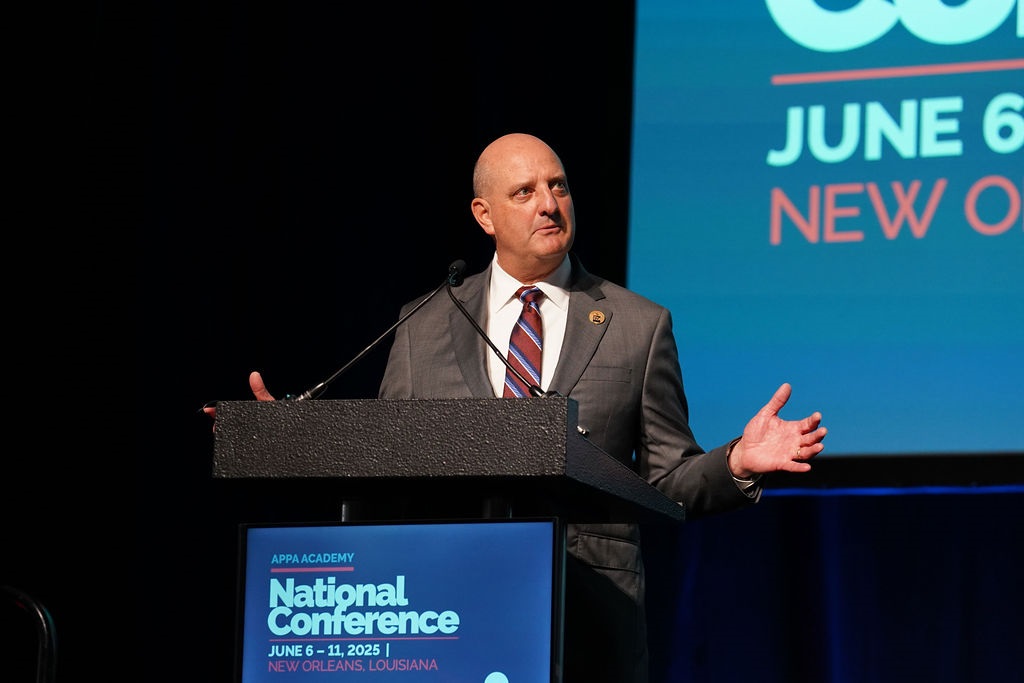In remarks made on June 9 at the American Public Power Association’s National Conference in New Orleans, La., Scott Corwin, President and CEO of APPA, highlighted the legacy of the Association and its 85 years of service to its public power members and said that public power utilities do not underestimate today’s challenges, and “protection of the affordability and reliability of our electricity service demands action.”
“From inception, APPA was driven by the power of its people at both the local level and in Washington, D.C. and thanks to members like all of you here today, for 85 years APPA has been connecting leaders and inspiring excellence,” he said.
“On our 85th anniversary, it’s tempting for me in these comments to stay with reflections of our storied past because what a past it has been. Yet, our eyes are more focused now in the present, and in preparing for a future that can seem ominous these days. Rather than letting that future overwhelm us, we gain wisdom from our past and then we take on that future in the increments in which it presents itself.”
Corwin said that public power is very good at the ability “to learn, to assess, to address the current situation, and then look forward in preparation to shape what comes next. We live not for our memories, but for our aspirations.”
He said that is a “particularly valuable trait now when our industry is evolving so quickly that the trends and technologies will be distant memories before we know it.”

In 2025, “it feels as if there is plenty to worry about in an ever-changing present and in the future, even outside of the dynamic policy aspects that have kept us on our toes,” he said.
“You know the list: higher costs, supply chain issues, difficulties siting and permitting infrastructure, cyber and physical security threats, natural disasters, resource adequacy concerns that demand growth is outpacing our ability to add new generation and transmission, and workforce factors that make it difficult to adequately staff to address the rest of that list,” he said.
“We do not underestimate these threats – certainly not when it comes to the barrage of cyber attacks from nation-state actors, or with respect to reliability where there is a clear and present danger.”
On resource adequacy, “we cannot continue down the path that increases the threat of outages during the most vulnerable times for our customers, namely the winter and summer peaks. There are ways to fix some of the policies that make it difficult to meet that demand. But getting momentum behind the answers has been difficult, to say the least. Power generation is tough to site and build, and when it is built it waits to get onto the grid in a long backup of interconnection requests,” Corwin said.
“Operators clearly see the fragility of a constrained system just as customers are feeling the hit to affordability.”
Corwin said it will take “all of us working together to fulfill the vision of safe, affordable, reliable power for all, and to increase system resilience and technological capability. You are the voice of power in local communities, a voice that is more important today than ever as these communities face those challenges and look for the opportunities that arise from them.”
The ability to act on that vision “starts with you, and some of the greatest opportunities in decades are upon us right now.”
This timing for action “on some of our key priorities creates potential for community owned power to own more, to modernize, and to connect even more with customers if we seize this time and band together with other public power communities,” he said.
“We are stronger together when acting collectively through APPA and through entities like joint action agencies to aggregate our expertise and our economic and political weight,” Corwin noted.
“How are we strategizing for that future while embracing the moment? One thing we are doing is bringing a strong collective voice in Washington to those in charge of the federal policies impacting us.”
This winter, “you all answered the call and came to D.C. amidst this swirl of activity with a new Administration and Congress, and you told your stories of community owned power and those stories rang true with those elected officials, in part because many of you are elected as well, or you answer directly to those who represent the public in your communities. You speak with authority of that important link between locally governed electricity and economic prosperity in the hundreds of Congressional districts across this great nation.”
Meeting with leadership in Congress, “focusing recently on the committees with tax jurisdiction, we have been telling our story about the importance of municipal finance to local communities. With your help we created a nation-wide map with specific community impacts of tax-exempt finance throughout the country.”
John Godfrey and the rest of the APPA staff “have worked hard and connected with you to hold the line on this issue, and so far it has held,” Corwin said.
“We have a compelling case -- it only makes sense – this is the toolkit that builds and maintains the infrastructure that runs our communities,” he said, noting that municipal finance funds 75% of core infrastructure. “There is still a long way to go in the budget process – we’re not taking anything for granted. We will be working the issue, and others with you, like keeping the long-fought-for ability to use tax credits to build needed generation, and preserving support for low-income energy assistance.”
Corwin also noted that “We are meeting with new administration officials, and many of them recognize our connection to local communities and share our desire to see more reasonable regulatory processes. An overhaul is long overdue on the arduous maze we navigate to get permits to maintain and build infrastructure that is critical to providing the power necessary for almost every aspect of human life.”
Time is Now to Act
“In this new action-oriented setting, it is incumbent upon us to strategically step up and chart the path to achieve our goals. It’s time to act,” the APPA President and CEO went on to say.
“In urgent times, real action is the only logical path to the needed result. Discussion, contemplation, writing reports, holding hearings – they may be necessary steps, but protection of the affordability and reliability of our electricity service needs action, and action” is what we must demand, Corwin said.
By way of example, he noted that APPA supports, and is seeing some action, on the Reliable Power Act currently moving through Congress to keep federal agencies from imposing regulations that would adversely affect reliability of the bulk power system.
“We at APPA are also informing and assisting the Administration and Congress as they explore approaches to ensuring grid security and resilience, including disaster response where there are certainly areas” of federal programs that could improve, Corwin said.
“But having effective federal support to address massive events is still critical,” he pointed out.
This past year, public power utilities acted by being part of a national mutual aid network. “You showed how public power looks out for each other during wildfires, during multiple severe storms and this has prompted more APPA commendations this year than ever.” Corwin noted that more than 350 public power utilities were “recognized for their actions.”
Corwin noted that he also had the opportunity to see firsthand lineworker crews participating in this year’s Light Up Navajo initiative, an effort that helps bring electricity to families in need in the Navajo Nation.
“If you want a quick refill of your faith in the human spirit just witness these crews driving for days across the country and then arduously drilling through rock in the desert heat” to bring power to a remote homestead.
Beyond the fundamentals of advocacy and policy, “APPA is striving to engage and to listen to your needs,” he said, noting that APPA is “finding new creative ways through education, certification programs, and technical assistance to support local public power priorities.”
APPA is “ready to assist you in achieving operational excellence through enhancing distribution performance, enabling effective power supply management, maintaining strong financial health, making critical forward-looking investments,” raising awareness of “public power’s value in your local community,” promoting human resource excellence and providing superior customer service.
Corwin used his closing remarks to honor APPA’s 85th anniversary.
The year 1940 “sounds like a long time ago, but of course public power started well before that -- at least as far back as 1881 in Butler, Missouri. Why did this model grow to 2,000 communities across the most diverse geography and demographics imaginable? Why this mission? Why do we do what we do?”
He said that the why “derives from members of our communities who call upon us, who trust in us. We’ve met the challenges of building the original infrastructure,” of deregulation, of overregulation, of technological advancement, and of changes in the modern customer relationship.
The founders “from the start were from all corners of the country from the West Coast to East.”
They originally met in Kansas City in 1940, and then moved the meetings to other cities. “Your communities were, and still are, the yardstick, envisioned by FDR and others, as the standard of accountability, of affordability, of reliability against which others can be measured. We set the standard. We have since the start.”
He continued: “Now we must step up with the next chapter of this story in a newly forged version of why we do what we do for our communities. It is the same fundamental public service ethic, but in a whole new package. We are evolving each year and bringing the next generation of engineers, and lineworkers, and accountants, and IT staff, and customer service reps into our story, into our mission.”
When talking about seizing opportunity out of challenge, “it means optimizing investment in our people – as much as any optimization of strategic financial investment – our people” are the greatest asset for public power utilities.
In 1940, “even as some of our utilities were still taking form, that opportunity took the form of helping the oncoming war effort, enabling the power and production that helped the allies prevail. Today it can mean anything from embracing the enormity of a data facility feeding the demand for AI, to installing the first ever comprehensive monitoring, detection, and mitigation of severe threats like wildfire or cyber-attacks.”

